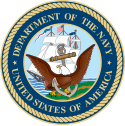Harold R. Stark
| ||
 | ||
| Data i miejsce urodzenia | 12 listopada 1880 Wilkes-Barre | |
| Data i miejsce śmierci | 20 sierpnia 1972 Waszyngton | |
| Przebieg służby | ||
| Lata służby | 1899–1946 | |
| Siły zbrojne | ||
| Stanowiska | Chief of Naval Operations, dowódca US Naval Forces w Europie | |
| Główne wojny i bitwy | I wojna światowa II wojna światowa | |
| Odznaczenia | ||
| | ||
Harold Rainsford Stark (ur. 12 listopada 1880 w Wilkes-Barre, zm. 20 sierpnia 1972 w Waszyngtonie)[1] – admirał amerykański.
Zarys biografii
W 1903 ukończył Akademię Marynarki Wojennej Stanów Zjednoczonych.
Jako Szef Operacji Morskich (CNO), piastował najwyższą funkcję wojskową w Marynarce Wojennej Stanów Zjednoczonych, gdy samoloty japońskie 7 grudnia 1941 zaatakowały Pearl Harbor. Wkrótce prezydent Roosevelt zdecydował się przywrócić stanowisko głównodowodzącego US Navy i powierzył je admirałowi Kingowi, a nie Starkowi, o czym przesądziła klęska w Pearl Harbor[2].
W marcu 1942 objął dowodzenie amerykańskimi siłami morskimi w Europie, które sprawował do sierpnia 1945. Ustalenia komisji śledczej w sprawie Pearl Harbor skłoniły dowódcę marynarki wojennej do wydania zakazu sprawowania przez niego stanowiska wiążącego się z dużą odpowiedzialnością. choć później uznano zakaz za zbyt surowy. Stark nie powrócił do czynnej służby.
Pamięć
Jego imię nadano fregacie rakietowej USS „Stark”.
Zobacz też
Przypisy
- ↑ Arlington National Cemetery Website – Harold Rainsford Stark (ang.) [dostęp 2014-03-16]
- ↑ S. Żerko, Biograficzny leksykon II wojny światowej, Poznań 2013, s. 385.
Bibliografia
Media użyte na tej stronie
Ribbon for the Navy Distinguished Service Medal awarded by the United States Department of the Navy.
Ribbon for the Distinguished Service Medal awarded by the United States Army.
Ribbon for the World War I Victory Medal awarded by the Allies:
- w:World War I Victory Medal (United States) awarded by the w:United States Department of Defense
- w:Victory Medal (United Kingdom) also called the Inter-Allied Victory Medal
- w:Médaille Interalliée 1914–1918 (France)
- w:Inter-Allied Victory Medal (Greece)
- w:Allied Victory Medal (Italy)
- etc.
Ribbon for the American Defense Service Medal awarded by the United States Department of Defense.
Ribbon for the World War II Victory Medal awarded by the United States Department of Defense.
Ribbon for the Distinguished Service Medal awarded by the United States Army.
Naramiennik stopnia Admiral (United States Navy).
*Description: On a circular background of fair sky and moderate sea with land in sinister base, a tri-mast square rigged ship under way before a fair breeze with after top-sail furled, commission pennant atop the foremast, National Ensign atop the main, and the commodore's flag atop the mizzen. In front of the ship a luce-type anchor inclined slightly bendwise with the crown resting on the land and, in front of the shank and in back of the dexter fluke, an American bald eagle rising to sinister regarding to dexter, one foot on the ground, the other resting on the anchor near the shank; all in proper colors. The whole within a blue annulet bearing the inscription "Department of the Navy" at the top and "United States of America" at the bottom, separated on each side by a mullet and within a rim in the form of a rope; inscription, rope, mullet, and edges of annulet all gold. *Background: The policy for use of the Navy seal and emblem is contained in SECNAV Instr 5030.4 and SECNAV Instr 5030.6. The seal design was approved by the President of the United States by Executive Order 10736 dated October 23, 1957. Request for use of the Navy emblem should be submitted in writing to Defense Printing Service, ATTN: DPSMO, 8725 John Kingman Rd Suite 3239, Fort Belvoir, VA 22060-6220. The telephone number is (703) 767-4218. 1879 version here: http://etc.usf.edu/clipart/54900/54985/54985_seal_navy.htm
Autor: Lestatdelc, Licencja: CC BY-SA 3.0
Illustration of a gold Award star ribbon device for military decorations
Flag of the United States Chief of Naval Operations. The position was created in 1915, but the flag just dates from 1964. It is defined in naval regulations, document NTP 13(B) [1] section 1810, as:
- The personal flag of the Chief of Naval Operations consists of a blue and white rectangular background divided diagonally from lower hoist to upper fly, blue above and white below. In the center of the flag appears an adaption of the center of the official seal of the Chief of Naval Operations, consisting of an eagle clutching an anchor, all in proper colors, encircled by fifty links of gold chain. Directly above, below and to each side of the circular center design is a 5-point star with one point upward. On the blue field the two stars are white and on the white field the two stars are blue. A gold fringe is authorized for use with the flag when it is displayed in a static indoor position. The cord and tassels are of golden yellow.
Ribbon for the European-African-Middle Eastern Campaign Medal awarded by the United States Department of Defense.
Ribbon for the Navy Distinguished Service Medal awarded by the United States Department of the Navy.
Ribbon for the American Campaign Medal awarded by the United States Department of Defense.













